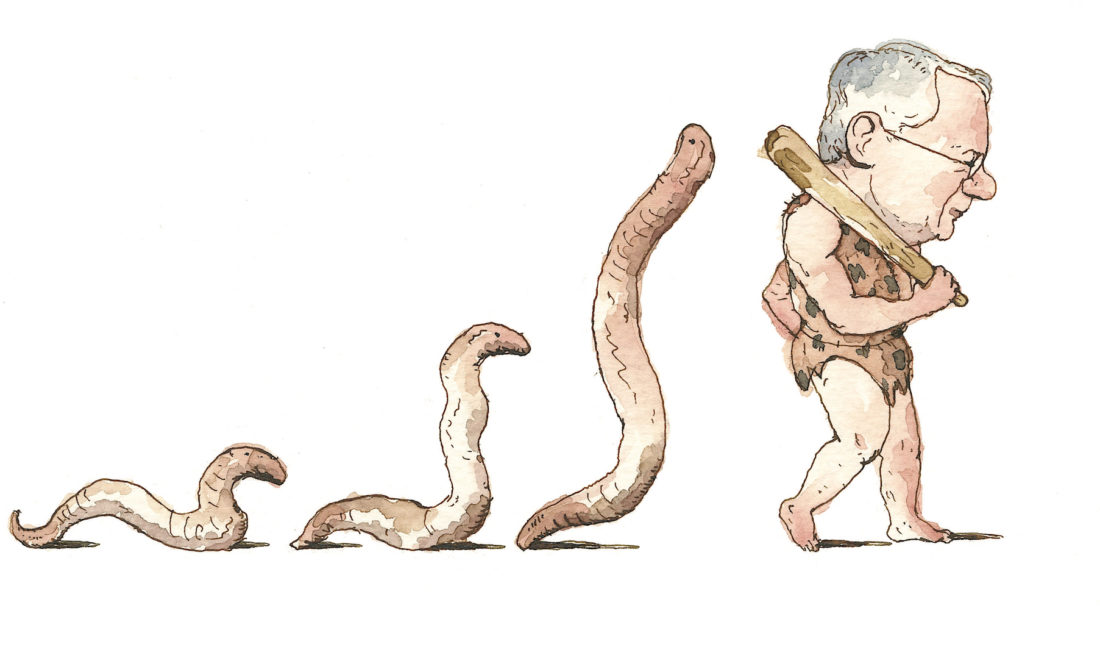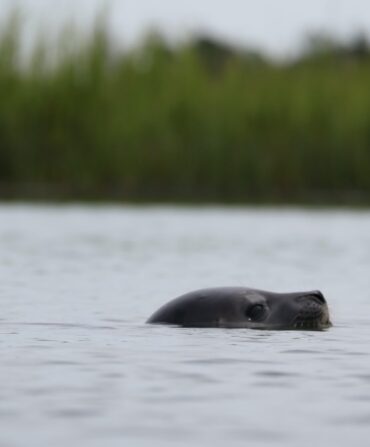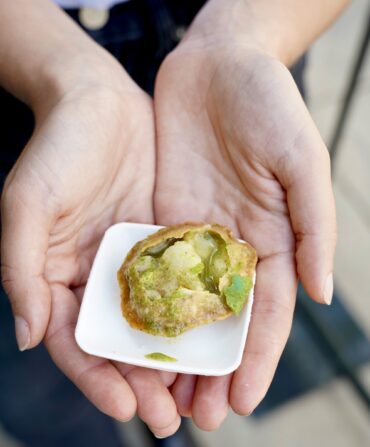Earthworm poetry relieved my childhood fears. As to burial:
The worms crawl in,
The worms crawl out,
The worms play pinochle
On your snout.
A solitary sort of kid, a digger, close to the ground, I had often been down on the level of worms. As to being different, which I was:
Nobody likes me,
Everybody hates me,
Guess I’ll go eat worms.
I wasn’t that different. Maybe not much more different, fundamentally, than anybody else.
As I grew older and more confidently sophisticated, I found my all-time favorite comic strip. In the Okefenokee Swamp, a.k.a. the Land of Trembling Earth, not too many miles from my own backyard, lived a possum named Pogo, who was not stupid like Li’l Abner, and who got along fine with worms.
Worm characters were not prominent in Pogo. None of them had names, which was too bad because Walt Kelly, the cartoonist, was a genius namer (how about Solid MacHogany, a New Orleans jazz-playing pig?). None of them had visible faces, either. But they did crop up. I turn to one of my many book-length collections of Pogo strips and almost immediately find Ol’ Mouse (no other name, but he wore a bowler hat, carried a cane, smoked a cigar, and sang) challenging a worm youngster who throws Ol’ Mouse with a judo hold. We might sum up earthworm characters in Pogo as follows:
Sociable, in an uneffusive way. Sometimes mistaken for a possum’s tail, or vice versa. Able to take care of themselves.
In Pogo you never see a worm on a hook. Fishing happens. Fish are eaten. Fish may wind up in characters’ hats or pants. It is hard to imagine fishing in Pogo entailing any bait other than worms. (Well, bugs, but the bugs in Pogo tend to be outspoken on their own behalf.) Yet worms in Pogo are never portrayed as lacking agency.
As a youth, I fished with worms sometimes, and felt entitled to. But I did not regard worms merely as bait.
And then, when I grew up and acquired my own yard, worms and I became gardening partners. I thrived on food and newspapers, and worms thrived on refining my scraps into a richer waste, and on that waste thrived my plants. How often do you get yourself into a cycle as virtuous as that?
Charles Darwin, you know, studied earthworms for forty years. Played the bassoon to them. Put them on the soundboard of his piano. Produced a book about them that I have a copy of, somewhere: The Formation of Vegetable Mould through the Action of Worms, with Observations of Their Habits. “It may be doubted,” Darwin writes, “whether there are many other animals which have played so important a part in the history of the world, as have these lowly organized creatures.”
Now we come to history’s downward pivot.
Darwin’s turf had never been invaded by jumping worms. Or crazy worms, snake worms, Alabama jumpers. Why Alabama I don’t know, because this ruddy-brown tide of invasive Asian earthworms has spread through the South, the Midwest, the Northeast, and as far northwest as Oregon. When I first encountered these worms in my yard, I thought, Aw, they’re excited to see me. But no. They are just hyperactive. And voracious. Jumping worms do not aerate the soil much. And do they convert dead leaves and stuff into the “black gold” prized by connoisseurs of fine compost? No. They turn it into dry, pebbly dirt often compared to used coffee grounds or taco meat. Not to mention how it may affect our appetite for tacos, this is not a good look for loam.
Actually, agronomists today tend to believe that even good worms take more than they give to woodlots. But these bad ones are so greedy around maple trees that they threaten the institution of maple syrup. And they drive out the good worms entirely.
Here’s how you can tell a jumping worm: When you pick them (here I use the appropriate pronoun) up, they thrash and flail. You know how there’s a little band around an earthworm? That’s their clitellum, which contains their sexual apparatus. In an old-fashioned gettin’-along worm, the clitellum is closer to the middle. In a jumping worm, the clitellum is slicker and way up front. The jumping worm is likely to be found right next to the surface. It is likely to present in a big squirming mess of them.
Kill them. No one will object. If you feel a twinge of mercy toward jumping worms, consider this: A single one can reproduce by themself. What kind of way is that to be? Stomp them! There’s nobody waiting for them at home.








